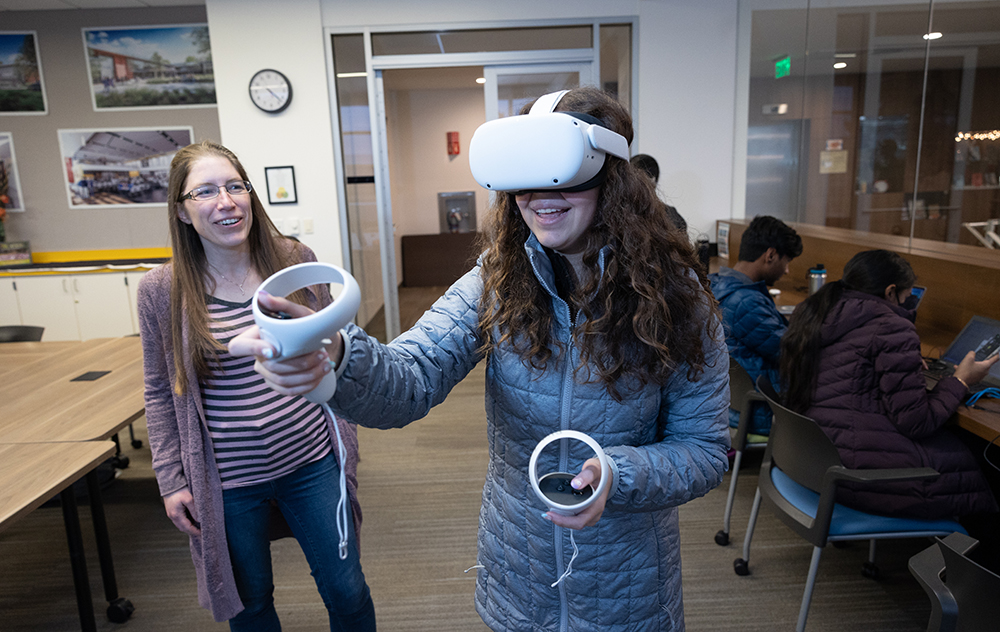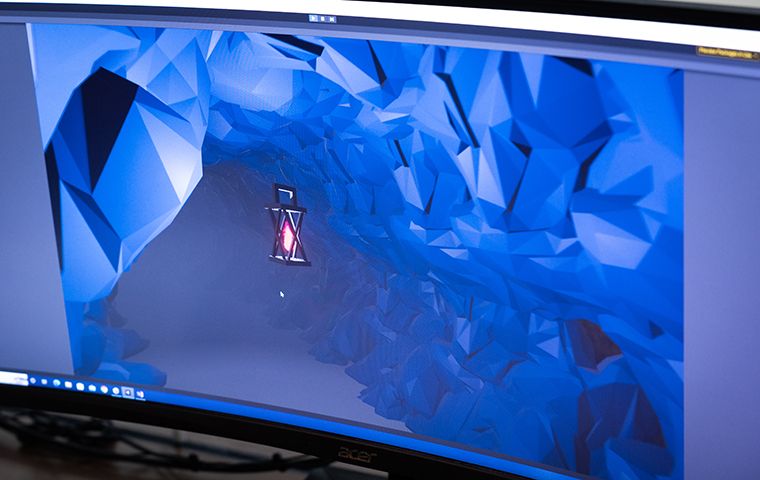
Scaling the Impact of Santa Clara’s Healthcare Innovation and Design Program
Through a partnership with an area high school, Santa Clara students and faculty are now offering young people mentorship and access to real-world inspired projects.
During the height of the COVID-19 pandemic in the summer of 2021, timing was critical. To effectively treat patients and prevent the spread of the virus, public health organizations didn’t just need to know what was happening now, but what was going to happen.
Navid Shaghaghi, a lecturer in mathematics and computer science was on the front lines of this effort. Using machine learning software he developed with Santa Clara University students, Shaghaghi and his team took publicly available flu data to forecast how COVID-19 might spread in different regions worldwide.
“We did three-week, seven-week, and 14-week predictions,” Shaghaghi says. “That way, pharmaceutical companies could be exactly on target with their week-to-week production of tests and medication.”
The project was a huge success. The forecasts were shared with different organizations around the world, including Cepheid, a Sunnyvale-based molecular diagnostics firm that makes COVID test kits and regularly partners with the Healthcare Innovation and Design Program at Santa Clara. The students also published several papers on their findings and shared their tool with top medical facilities like Johns Hopkins University so forecasts could get to those who needed them even faster.
While Shaghaghi and his team of Santa Clara students led the project, they didn’t do it alone. In fact, they got help from an unexpected source: Saint Francis High School in Mountain View.
Inspired by an idea from Prashanth Asuri, director of SCU’s Healthcare Innovation and Design Program, a group of seven students at Saint Francis received coding training from Santa Clara students George Kouretas ’22, Andres Calle ’21, and Michael Castillo ’24. The high school students then spent four weeks troubleshooting the software in the project’s final stage, using machine learning and programming skills to debug and synthesize the code. At the end of the five weeks, the high school students presented their findings to the Santa Clara team.
Asuri’s goal for the collaboration wasn’t just to assist with the completion of the project but to expand the impact of the Healthcare Innovation and Design Program. By taking the model he uses to link Silicon Valley companies and Santa Clara students, he could provide high school students the same hands-on opportunities on relevant projects while giving Santa Clara students experience in teaching and leadership.
“I always tell young people, ‘You need to be interested in larger problems,’” Asuri says. “Don’t just worry about what specific discipline you should study in college. Instead, attach yourselves to a grand challenge you would like to solve, like energy, health, or sustainability.”
With the initial success of the partnership with Saint Francis, Asuri decided to keep the collaboration going. But rather than extending this single project, he expanded the scope of the partnership and range of student involvement through new experiential learning opportunities.
With the help of Julia Scott, director of the Brain and Memory Care Lab at Santa Clara, and Shraddha Chaplot, Head of Innovation at Saint Francis, the high school students designed a virtual reality program that focused on improving mental health.
In the VR game engine, students created their own virtual environment that enhances relaxation. They also built sensors that detect heart rate, which is then used as an interactive part of the game. In the final design, the user walks into a peaceful virtual cave with calming, colorful crystals, and glow worms hanging from the top to replicate the soothing effects of bioluminescence.

With support from Em Dang of Santa Clara’s Imaginarium, a new crop of Saint Francis students created their own virtual reality experience that takes the user through calming and tense environments to build awareness of emotions and heart rate.
Chaplot says the experience helped to address the age-old question of young people, “When am I ever going to use this?” While it can be difficult to answer this question in a traditional classroom environment, through the VR project, her students could easily see how geometry and algebra principles could be creatively applied to visual art. They also learned hard skills like electrical engineering and computer programming.
“These opportunities help them see why they're learning what they’re learning,” Chaplot says.
Perhaps most impactful, since the work was done through a voluntary program, there were no grades or competitions. Students were able to experiment without fear of failure or expectations, which can be rare in a competitive high school environment.
“I want kids to explore and try new things without a fear of failure,” Chaplot says. “Through these types of projects, if our students find they have an affinity for VR or healthcare, that’s amazing, but if they don't, that's okay too. It’s all part of the process. They are learning about themselves, finding their strengths, and discovering their passions so they can make a positive impact on the world.”
Upping Their Game
Saint Francis students have continued the VR project this fall. With additional support from Em Dang of Santa Clara’s Imaginarium, a new group of students has created their own version of the experience that takes the user through calming and tense environments to build awareness of emotions and heart rate.
“They have created a more complex world and interactions, literally upping their game,” Scott says.
The project will continue this month with a series of events. Santa Clara students Ginger Freeman ’23 (psychology) and Soren Madsen ’21, M.S. ’24 (computer science and engineering) will return to Saint Francis to oversee test runs and provide feedback. On Wednesday, Dec. 14, Saint Francis will host “An Evening in Virtual Reality,” where students will showcase the work they’ve done on the project.
I want kids to explore and try new things without a fear of failure. Through these types of projects, if our students find they have an affinity for VR or healthcare, that’s amazing, but if they don't, that's okay too. It’s all part of the process.”
Saint Francis has also recently started a third project, a design challenge inspired by dementia care innovation supported by Maude’s Ventures in the lab. Four student teams developed prototypes to address a key need in dementia care over a 10-week period. They pitched their ideas to a live audience and judging panel on November 30. Santa Clara Professor Patti Simone (Psychology), Asuri, and McKenzie Himes ’23 (Neuroscience) provided constructive feedback on their designs to prepare them for the next phase of the project.
Based on the success of the Saint Francis collaboration, Scott and Asuri hope to scale the program even further, specifically with schools that don’t traditionally have the resources of a private school.
The biggest hurdle to scaling the program isn’t hardware, but training teachers to oversee the projects, according to Scott. She is seeking opportunities that would fund this kind of teacher training at other high schools in order to create sustainable programs in XR innovation.
“We're working on securing other high school partners for additional pilot sites,” Scott says. “Each school has different needs and wants different outcomes. So we want to create a framework that can be adapted to multiple educational settings that's inclusive of public schools, other types of private schools, and after-school programs or community programs.”
While the initiative has opened a lot of new opportunities for Saint Francis students, Scott stresses that the partnership has been just as valuable for Santa Clara. By sharing their expertise and passions, Santa Clara students have strengthened project leadership skills and expanded their understanding of the subject matter.
“These projects cooperatively strengthen both student bodies,” Scott says. “Hopefully, we can build similar partnerships with other high schools to expand learning opportunities and continue to push the boundaries of engineering, entrepreneurship, and design thinking.”
Julia Scott (left), director of the Brain and Memory Care Lab at Santa Clara, and students at Saint Francis High School designed a virtual reality program focused on improving mental health.